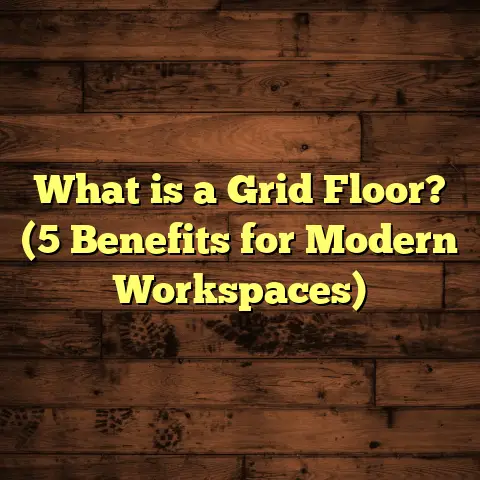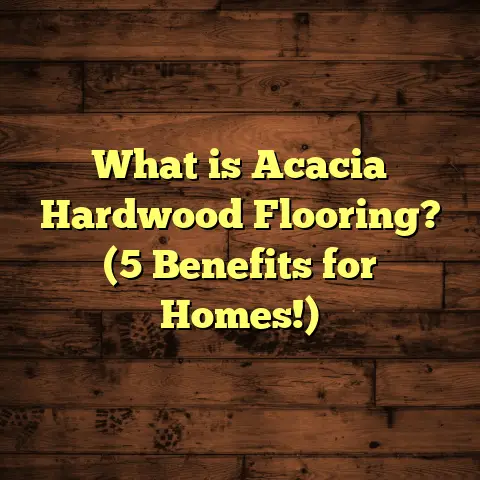What is an Open Concept Floor Plan? (5 Benefits for Modern Living)
Innovation in home design has always fascinated me. Over the years, I’ve witnessed how new ideas shape the way we live, interact, and even feel inside our homes. One of the shifts I found particularly interesting is the rise of the open concept floor plan. It’s not just about aesthetics; it’s about how a home functions in everyday life. When I first got into flooring and remodeling, I saw firsthand how changing walls and layouts could transform not just a room, but the entire living experience.
What is an Open Concept Floor Plan?
Alright, so what exactly do people mean when they say “open concept floor plan”? If you’re like many who’ve heard the term but aren’t quite sure what it entails, here’s a simple explanation.
An open concept floor plan is a layout where two or more traditionally separate rooms—usually the kitchen, dining room, and living room—are combined into one large space without walls or partitions separating them. The idea is to create a continuous flow that enhances light, sightlines, and interaction. It breaks down barriers that once divided these spaces, making a home feel larger and more connected.
I remember when I first saw an open concept home during a renovation project. The kitchen flowed seamlessly into the living area with no walls in between. It felt like the whole space was breathing—airy and welcoming. The homeowners told me it changed how they used their home daily; family members could talk and move freely without feeling boxed into separate rooms.
A Brief History
The open concept isn’t exactly new; it gained popularity in mid-20th century modern architecture but really exploded in mainstream home design over the last 20 years. Older homes typically had segmented rooms separated by walls and doors. This was great for privacy but often left spaces feeling closed off and dark.
With shifting lifestyles emphasizing family togetherness and casual entertaining, designers began knocking down walls to create expansive living areas. Today, whether in new builds or remodels, open plans are a go-to for modern homes.
Why Do People Choose Open Concept Plans?
From my experience talking to homeowners, there are several reasons why this layout resonates:
- Social Interaction: Families want to spend time together even while doing different activities.
- Natural Light: Open spaces allow sunlight to travel farther, brightening up the home.
- Flexibility: Rooms can serve multiple purposes since there are fewer physical divisions.
- Aesthetic Appeal: Clean lines and spaciousness feel contemporary and inviting.
- Resale Value: Buyers often prefer open layouts for their versatility and style.
Let me take you through these benefits one by one, sharing stories, data, and insights to help you understand why open concept might be worth considering.
1. Enhanced Natural Light and Airflow
Have you ever been in a house where rooms feel cramped and dim? That’s usually because walls block light and airflow. Open concept floor plans solve this problem beautifully.
Without dividing walls, sunlight can flood deeper into the house. This doesn’t just make spaces look better; it influences mood and energy levels positively.
I worked on a project where we removed walls separating the kitchen from the living room. Before, the kitchen was gloomy despite having windows because the light couldn’t travel past the wall. After opening it up, light poured across the entire area, making mornings feel brighter and evenings warmer.
Data on Natural Light Benefits
According to research from the National Renewable Energy Laboratory (NREL), homes with open layouts reduce reliance on artificial lighting by up to 20% during daylight hours. This not only lowers energy bills but also contributes to better health by exposing occupants to natural light cycles.
Additionally, improved airflow helps with ventilation, reducing indoor air pollutants and humidity buildup—a big plus for comfort and health.
Practical Tips
If you’re thinking of going open concept but worried about lighting, consider:
- Installing larger windows or skylights to maximize sunlight.
- Using light-colored floors and walls to reflect light better.
- Choosing flooring materials that enhance brightness—like light-toned hardwood or vinyl planks.
2. Better Space Utilization and Flexibility
One of the biggest perks I see in open floor plans is how much more spacious homes feel without extra square footage. You don’t have to move or extend your house to get that roomy vibe.
When we remove walls, spaces visually blend together. This optical illusion makes even smaller homes feel much bigger.
I had a client in a 900 square foot urban condo who wanted more usable space without moving. By opening up her kitchen into the living area, she suddenly had room for a small dining table AND a cozy reading nook she’d always wanted.
Flexibility in Use
Open plans let you adapt spaces easily:
- Create a work-from-home corner during weekdays.
- Set up a play area for kids while keeping an eye from the couch.
- Rearrange furniture for parties or quiet nights without restrictions of walls.
This flexibility is valuable as lifestyles change—whether kids grow up or you start hosting more guests. You can shift your furniture and uses without costly renovations.
How Flooring Plays a Role
With open spaces, flooring becomes a unifying element. I usually recommend choosing consistent flooring throughout these areas for a seamless look. Hardwood floors or luxury vinyl planks work well—they’re durable and easy to clean across large zones.
When calculating material needs for these bigger open areas, I use tools like FloorTally. It helps me estimate exact quantities plus labor costs based on my measurements. The tool’s waste factor calculation is handy too because flooring always requires some extra material due to cuts or mistakes.
This kind of precision saves me time and money—and clients appreciate knowing their budget upfront.
3. Encourages Social Interaction and Family Bonding
One thing I often hear from families who switch to open concept is how much it improves their connection. Without walls separating people into isolated rooms, conversations flow naturally.
I recall working with a family who had young kids and wanted to be able to cook dinner while still watching their children play or do homework nearby. After removing a bulky wall between kitchen and living room, they said it felt like they were all together even when doing different things.
Data on Social Benefits
A survey by Houzz found that 73% of homeowners with open layouts reported improved family communication. People feel less isolated when they can see each other easily and chat without shouting through doors.
This also makes hosting guests more fun; cooks don’t miss out on conversations while preparing food, and guests don’t feel separated into different rooms.
Design Ideas
To maximize social benefits:
- Arrange seating to encourage face-to-face interaction.
- Add an island or breakfast bar in the kitchen where people can gather.
- Use rugs or lighting zones to define areas without breaking openness.
4. Simplifies Supervision and Safety
If you have kids or pets, an open concept can be a game changer for keeping an eye on things without running around from one spot to another.
I’ve worked with many parents who appreciate being able to cook or work while still supervising playtimes or homework sessions in the same sightline.
One couple I helped renovate said they felt much less stressed after opening up their home because they could see their toddler at all times without having to yell across walls or doors.
Safety Perks
Open spaces reduce blind spots where accidents might happen unnoticed. If your child trips or your pet gets into something off-limits, you’re more likely to catch it early.
Also, fewer walls mean fewer sharp corners or obstacles for running kids or pets, making movement safer overall.
5. Modern Aesthetic Appeal and Increased Home Value
Let’s be honest: open concept homes just look modern and stylish. Clean lines, uninterrupted sightlines, and spaciousness are highly sought after in today’s market.
From my experience helping homeowners remodel or sell properties, this kind of layout often leads to faster sales and sometimes higher prices compared to traditional segmented homes.
Stats on Resale Value
Zillow reports that homes featuring open floor plans usually sell quicker than those with closed-off rooms. Remodeling Magazine’s 2023 Cost vs Value report states that kitchen remodels incorporating open layouts recoup 60-70% of their costs at resale—a significant return on investment.
Another study by the American Society of Interior Designers noted that open floor plans have surged by over 40% in popularity over the last decade among buyers.
Styling Tips
To keep your open concept looking fresh:
- Use consistent color palettes across spaces.
- Incorporate statement lighting fixtures over dining or island areas.
- Add texture with rugs, cushions, or wall art to create cozy zones within openness.
Flooring Considerations for Open Concept Spaces
Since I specialize in flooring, I want to share some insights about choosing floors for open concept homes because this decision affects both aesthetics and function greatly.
Consistency is Key
With no walls separating rooms visually, flooring becomes one of the main ways to define space cohesively. Using different floors in each area can break flow unless done thoughtfully.
I usually suggest:
- Using one type of flooring throughout (like hardwood or luxury vinyl).
- Or picking materials with similar tones/finishes if mixing (e.g., tile in kitchen with matching wood-look vinyl in living).
Durable & Easy Care Options
Open spaces get lots of traffic since they combine multiple functions—cooking, dining, relaxing, working. Flooring needs to withstand wear without looking tired quickly.
Some materials I recommend:
- Engineered hardwood: Looks beautiful with excellent durability.
- Luxury vinyl plank (LVP): Water-resistant and budget-friendly.
- Porcelain tile: Perfect for kitchens but can be cold underfoot—consider area rugs for warmth.
Estimating Costs with FloorTally
Whenever I plan flooring installs for these large open areas, accurate measurement is critical to avoid costly overruns or shortages.
FloorTally has been my go-to tool because:
- It calculates material requirements based on room dimensions.
- Factors in waste percentage so I order enough extra material.
- Provides labor cost estimates which helps set clear budgets.
Using this app has saved me countless hours of manual calculations and helped clients avoid surprises during installation.
Addressing Challenges of Open Concept Living
While I’m all for open layouts, it’s fair to mention some potential downsides so you can weigh them carefully.
Noise Control
Without walls acting as sound barriers, noise can travel easily throughout the space—which might be distracting if someone’s working while others watch TV loudly nearby.
To manage this:
- Use soft furnishings like rugs, curtains, cushions to absorb sound.
- Consider acoustic panels if noise is a major concern.
- Create “quiet zones” by positioning furniture strategically away from noisy appliances.
Privacy
Open plans reduce privacy since there are fewer separate rooms. For some families or individuals needing private workspaces or quiet retreats, this can be challenging.
Solutions include:
- Installing sliding doors or room dividers that can close off sections when needed.
- Using furniture arrangements that create visual breaks.
Heating & Cooling
Sometimes heating or cooling large open spaces evenly can be tricky compared to smaller enclosed rooms.
Make sure your HVAC system is designed appropriately for such layouts or use supplemental solutions like ceiling fans or portable heaters/coolers as necessary.
Real-Life Case Studies From My Work
To give you a better picture of how open concept designs really impact lives, here are some stories from my projects:
Case Study 1: Urban Loft Conversion
A young couple bought an old downtown loft with tiny segmented rooms. They wanted something modern with lots of light for their home office needs plus entertaining friends.
We removed several non-load-bearing walls between kitchen, dining, and living areas. New wide plank hardwood flooring was installed throughout for consistency. Large windows were added where possible to boost sunlight further.
Result? They said it felt like living in a completely different home—airy yet cozy—with plenty of space for work and play. The open plan made hosting gatherings effortless because guests naturally mingled across the entire space.
Case Study 2: Suburban Family Home Remodel
This family had four kids and needed better supervision options plus an update to their outdated segmented home. We knocked down walls between kitchen/dining/living rooms creating one big shared space where parents could cook while kids did homework or played nearby safely.
Durable luxury vinyl plank flooring was chosen due to its water resistance (kids + spills!). The family reported less stress from juggling chores and supervising kids separately—they felt more connected every day now.
How Open Concept Fits Different Lifestyles
I’ve learned that people’s needs vary widely when choosing floor plans. Here’s how an open layout might suit different lifestyles:
| Lifestyle Type | How Open Concept Helps | Considerations |
|---|---|---|
| Young Families | Easier supervision & interaction | Noise control may need attention |
| Entertainers | Allows large gatherings & fluid socializing | Seating & space planning key |
| Remote Workers | Flexible multi-use zones | Need quiet zones & privacy options |
| Downsizers | Makes smaller spaces feel larger | Minimalist furniture works best |
| Empty Nesters | Modern look & easy maintenance | May want cozy defined zones |
Final Thoughts on Open Concept Floor Plans
I’ve shared my experiences and data about why open concept floor plans have become such popular choices—and why they might fit your lifestyle too. The benefits are clear: more light, flexible space use, closer family connections, easier supervision if you have kids or pets, plus modern aesthetics that add value when selling your home someday.
If you decide this layout suits your needs but worry about costs or materials—especially flooring—I highly recommend using tools like FloorTally to plan accurately. Knowing your material quantities and labor costs upfront saves headaches later during installation.
Curious about which flooring options work best? Need advice on remodeling your space? Just ask—I’m here to help!
If you want me to expand any section further with more data or stories or include installation tips specific to certain floors in open concepts—just say so!





